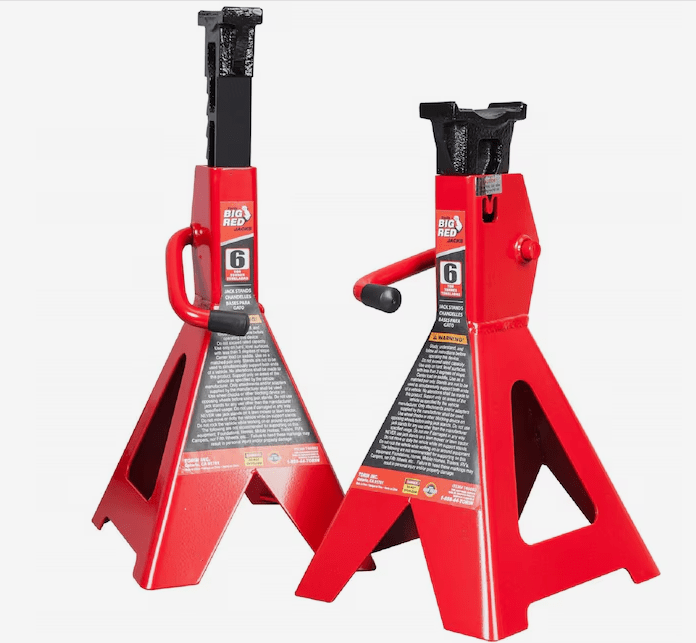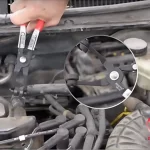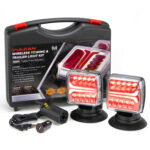What is a 6 Ton Jack Stand?
A 6 ton jack stand is a heavy-duty automotive tool designed to safely support and stabilize vehicles weighing up to 12,000 pounds (6 tons). It is an essential piece of equipment for mechanics, auto enthusiasts, and DIY car owners who need to lift and securely position their vehicles for maintenance, repairs, or modifications.
Jack stands are typically made of durable steel construction and feature a sturdy base with a vertical support column. The column has a saddle or cradle at the top, which is designed to fit snugly under the designated lift points of a vehicle, providing a stable and secure support system.
The 6 ton weight capacity of these jack stands makes them suitable for lifting and supporting a wide range of vehicles, from small cars and trucks to larger SUVs and vans. Their robust design and high weight rating ensure that they can handle the substantial weight of these vehicles without compromising safety or stability.
In addition to their impressive load-bearing capabilities, 6 ton jack stands often incorporate safety features such as locking mechanisms, adjustable height settings, and wide bases for enhanced stability. These features help prevent accidental slippage or tipping, providing peace of mind during automotive work.
Table of Contents
How Jack Stands Work
Jack stands are designed to safely support heavy loads, such as vehicles, machinery, or equipment, by distributing the weight evenly and securely. Their working principle is based on mechanical principles of load distribution and structural integrity.
Mechanical Principles
Jack stands rely on the principle of leverage to lift and support loads. They typically consist of a base, a vertical column or post, and a saddle or cradle at the top. The base provides a stable foundation, while the column acts as a lever arm, transferring the load from the saddle to the base. The saddle is designed to securely hold the load, preventing it from slipping or tipping.
Load Distribution
One of the critical aspects of jack stand design is proper load distribution. The base of a jack stand is typically wide and sturdy, providing a larger surface area to distribute the weight evenly across the ground or surface. This prevents the stand from sinking into soft ground or causing damage to the surface. The column and saddle are engineered to handle the specified load capacity without deforming or failing.
Construction Materials
Jack stands are typically constructed from high-strength materials, such as steel or aluminum alloys, to ensure durability and load-bearing capacity. Steel is often preferred for its strength and resistance to deformation, while aluminum alloys offer a lightweight alternative without compromising structural integrity.
The base, column, and saddle are carefully designed and manufactured to withstand the specified load capacity. The saddle, in particular, is often coated with a non-slip material or features a textured surface to prevent the load from sliding off the stand.
By understanding the mechanical principles, load distribution, and construction materials involved in jack stand design, users can safely and effectively support heavy loads, ensuring the stability and security of their projects or repair tasks.
When to Use 6 Ton Jack Stands
6 ton jack stands are designed for heavy-duty applications, such as lifting large vehicles or supporting significant weight during automotive repairs. These robust stands are typically recommended for vehicles weighing up to 12,000 pounds (5,443 kg), which includes most full-size pickup trucks, SUVs, and larger passenger vehicles.
One of the primary uses for 6 ton jack stands is during major repair jobs that require the vehicle to be safely elevated for an extended period. These tasks may include transmission repairs, exhaust system replacements, suspension work, or any job that necessitates access to the undercarriage or removal of major components. The high weight capacity of 6 ton stands ensures a secure and stable support, reducing the risk of the vehicle shifting or collapsing during the repair process.
Safety should always be the top priority when working with jack stands, regardless of their capacity. It is crucial to follow the manufacturer’s instructions and guidelines, ensuring that the stands are placed on a level, solid surface and properly positioned under the designated lift points of the vehicle. Additionally, it is recommended to use jack stand pairs for added stability and to never work under a vehicle supported solely by a jack or jack stands without additional safety precautions, such as wheel chocks or supplementary support.
Top 6 Ton Jack Stand Brands
When it comes to 6 ton jack stands, there are several leading manufacturers that stand out for their quality, durability, and reliability. Here are some of the top brands to consider:
Torin
Torin is a well-known brand in the automotive tools industry, and their 6 ton jack stands are among the best in the market. These stands are made from high-quality steel and feature a double-locking pin design for added safety. Torin’s jack stands are also known for their sturdy construction and easy-to-use design.
Hein-Werner
Hein-Werner is another reputable brand that offers a range of 6 ton jack stands. Their stands are made from heavy-duty steel and have a wide base for increased stability. Hein-Werner’s jack stands also come with a built-in safety pin and a large saddle area for better weight distribution.
Omega
Omega is a popular choice among automotive enthusiasts and professionals alike. Their 6 ton jack stands are made from high-strength steel and feature a double-locking mechanism for added security. Omega’s stands are also designed with a low profile, making them ideal for low-clearance vehicles.
Esco
Esco is a trusted brand that has been manufacturing automotive tools for decades. Their 6 ton jack stands are known for their robust construction and easy-to-use design. Esco’s stands feature a wide base and a large saddle area for increased stability and weight distribution.
Pro-Lift
Pro-Lift is a leading manufacturer of automotive lifting equipment, including 6 ton jack stands. Their stands are made from high-quality steel and feature a double-locking pin design for added safety. Pro-Lift’s jack stands are also designed with a low profile and a wide base for increased stability.
When it comes to customer ratings, these top brands consistently receive high marks for their quality, durability, and ease of use. Many customers praise the sturdy construction and reliable performance of these 6 ton jack stands, making them a popular choice among automotive professionals and DIY enthusiasts alike.
Jack Stand Safety Tips
Proper setup and use of jack stands is crucial for preventing severe injuries or fatalities. Always follow these essential safety precautions:
Proper Setup:
- Ensure the jack stands are placed on a flat, level, and solid surface that can support the vehicle’s weight.
- Position the jack stands at the manufacturer’s recommended lift points on the vehicle.
- Adjust the jack stand’s height to ensure it’s supporting the vehicle’s weight securely, with the load resting on the saddle, not the post.
- Use matched pairs of jack stands with the same load capacity and height.
Potential Hazards:
- Unstable or uneven surfaces can cause the jack stands to shift or collapse.
- Improper placement of jack stands can lead to the vehicle slipping off and crashing down.
- Using mismatched or damaged jack stands increases the risk of failure.
- Working under a vehicle supported solely by a hydraulic jack is extremely dangerous.
Prevention Measures:
- Inspect jack stands for any damage, cracks, or deformities before use, and replace them if necessary.
- Never exceed the rated load capacity of the jack stands.
- Chock the wheels to prevent the vehicle from rolling.
- Clear the area around the vehicle, ensuring no obstructions or debris can interfere with the jack stands.
- Never work under a vehicle supported only by a hydraulic jack; always use jack stands as a secondary support.
- Avoid jerky movements or rocking the vehicle while it’s supported by jack stands.
- Keep children and pets away from the work area.
Remember, safety should always be the top priority when working with jack stands. Take the necessary precautions to prevent accidents and ensure a secure working environment.
Maintaining Jack Stands
Proper maintenance is crucial for ensuring the longevity and safe operation of your 6 ton jack stands. Regular inspection, cleaning, lubrication, and proper storage can help prevent premature wear, corrosion, and potential failures.
Inspection
Before each use, thoroughly inspect your jack stands for any signs of damage, wear, or corrosion. Check for cracks, dents, or deformities in the metal components, as well as any loose or missing parts. Pay close attention to the load-bearing surfaces and the locking mechanisms. If you notice any issues, do not use the jack stands and replace them immediately.
Cleaning
Keep your jack stands clean and free from dirt, grease, and other contaminants that can accelerate wear or interfere with their operation. Use a degreaser or mild detergent and a stiff brush to remove any built-up grime or debris. Rinse thoroughly with water and allow the jack stands to dry completely before storing or using them.
Lubrication
Proper lubrication is essential for smooth operation and preventing premature wear. Follow the manufacturer’s recommendations for lubricating the moving parts, such as the locking mechanisms, pins, and adjustment points. Use a high-quality, rust-preventative lubricant suitable for the intended application.
Storage
When not in use, store your jack stands in a clean, dry, and protected environment, away from moisture, extreme temperatures, and direct sunlight. Avoid storing them in areas where they may be exposed to corrosive substances or excessive humidity. If storing for an extended period, consider applying a rust-preventative coating or lubricant to the exposed metal surfaces.
By following these maintenance practices, you can help ensure the longevity and reliable performance of your 6 ton jack stands, reducing the risk of failures and ensuring your safety during automotive repairs or maintenance tasks.
Jack Stand Regulations and Standards
Jack stands are essential safety equipment, and their design, manufacturing, and usage are governed by various regulations and standards to ensure maximum safety. The primary regulatory body overseeing jack stand standards in the United States is the American National Standards Institute (ANSI) and its accredited standards developer, the Portable Automotive Lifting Devices (PALD) Committee.
The ANSI/PALD standards outline specific requirements for jack stands, including load testing, material specifications, and performance criteria. All reputable jack stand manufacturers must comply with these standards and subject their products to rigorous testing to obtain ANSI/PALD certification.
Load testing is a crucial aspect of the certification process. Jack stands are tested to withstand loads significantly higher than their rated capacity to ensure a wide margin of safety. During load testing, the stands are subjected to various load scenarios, including off-center loading and impact tests, to simulate real-world conditions and potential misuse.
In addition to load testing, the ANSI/PALD standards also specify requirements for material composition, welding quality, and surface finishes. These standards ensure that jack stands are constructed from high-quality materials and manufactured to exacting tolerances, minimizing the risk of failure due to material defects or poor workmanship.
Compliance with ANSI/PALD standards is not just a recommendation; it’s a legal requirement for jack stand manufacturers. Any jack stands sold in the United States must bear the ANSI/PALD certification mark, indicating that they have undergone the necessary testing and meet the applicable safety standards.
By adhering to these stringent regulations and standards, consumers can have confidence in the safety and reliability of their 6-ton jack stands, knowing that they have been rigorously tested and certified to withstand the demands of automotive repair and maintenance tasks.
6 Ton vs Other Jack Stand Sizes
When it comes to jack stands, the size and capacity play a crucial role in determining their suitability for different applications. While 6-ton jack stands are a popular choice for many automotive and industrial tasks, it’s essential to understand how they compare to other available sizes.
Capacity Comparisons
The capacity of a jack stand refers to the maximum weight it can safely support. 6-ton jack stands, as the name suggests, are designed to hold up to 12,000 pounds (6 tons) of weight. This makes them suitable for lifting and supporting heavy vehicles like trucks, SUVs, and even some commercial vehicles.
In comparison, smaller jack stand sizes, such as 2-ton or 3-ton stands, are typically used for lighter vehicles like cars and smaller trucks. On the other hand, larger jack stand sizes, such as 10-ton or 12-ton stands, are often employed in industrial settings or for lifting and supporting extremely heavy machinery.
Use Cases
The primary use case for 6-ton jack stands is in automotive repair shops, garages, and home mechanics working on larger vehicles. They provide a stable and secure platform for lifting and supporting vehicles during maintenance, repairs, or modifications that require access to the undercarriage.
Additionally, 6-ton jack stands can be useful in various industrial settings, such as manufacturing facilities or construction sites, where heavy equipment or machinery needs to be lifted and supported for maintenance or repair.
Cost Differences
Generally, the cost of jack stands increases with their capacity. 6-ton jack stands tend to be more expensive than smaller sizes like 2-ton or 3-ton stands, but more affordable than larger industrial-grade stands with higher capacities.
The price difference is primarily due to the additional materials and reinforcements required to withstand the higher loads. However, it’s essential to invest in high-quality jack stands from reputable manufacturers, as compromising on safety can have severe consequences.
Jack Stand Accessories
Jack stand accessories can enhance safety, convenience, and organization when working with 6 ton jack stands. Some popular accessories include:
Wheel Chocks: These wedge-shaped blocks are placed against the tires to prevent the vehicle from rolling while it’s raised on jack stands. Wheel chocks provide an additional layer of safety and stability.
Jack Stand Pads: These durable rubber or plastic pads are placed under the jack stand’s base to protect surfaces like garage floors or driveways from scratches or dents. They also help prevent the jack stand from sinking into softer surfaces.
Storage Caddies: These handy caddies or racks are designed to store and organize multiple jack stands when not in use. They keep the stands organized, protected from damage, and easily accessible for your next project.
While not strictly necessary, these accessories can make working with 6 ton jack stands safer, more convenient, and better organized. Consider adding them to your automotive toolkit for a smoother and more efficient experience.
DIY vs Professional Jack Stand Use
For home auto repair enthusiasts, 6 ton jack stands provide a reliable and stable solution for lifting vehicles safely during maintenance or repair tasks. These heavy-duty stands are designed to support the weight of most passenger cars, trucks, and SUVs, making them a versatile choice for DIY mechanics.
However, in professional repair shop settings, the need for jack stands often extends beyond the capabilities of a 6 ton model. With larger vehicles such as commercial trucks, buses, and heavy-duty equipment, higher-capacity jack stands may be required to ensure safe and secure lifting.
Professional mechanics and technicians typically undergo specialized training in the proper use of jack stands and other automotive lifting equipment. This training emphasizes safety protocols, load capacity calculations, and proper positioning techniques to prevent accidents or equipment failures.
While DIY enthusiasts can certainly benefit from using 6 ton jack stands for home projects, it’s essential to follow all safety guidelines and weight capacity limitations provided by the manufacturer. Proper maintenance, inspection, and replacement of worn or damaged jack stands are also crucial for ensuring safe operation.
In contrast, professional repair shops often have more stringent safety protocols and quality control measures in place. Regular inspections, maintenance schedules, and adherence to industry standards and regulations help mitigate risks and ensure the longevity and reliability of their jack stand equipment.



